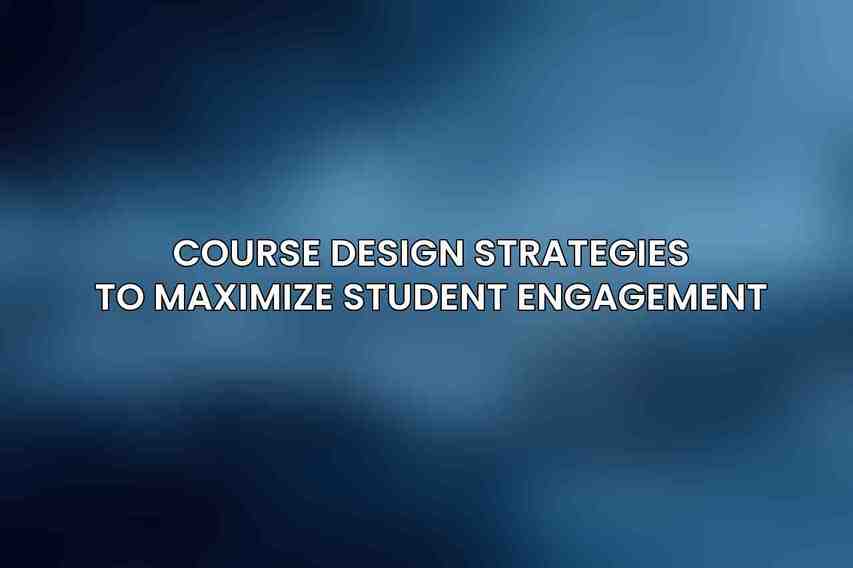student engagement is a crucial component that significantly impacts learning outcomes. Student engagement can be defined as the extent to which students are involved and invested in their learning experience. It encompasses their participation, interest, and motivation towards the educational content. Particularly in the context of online learning, where physical presence is absent, fostering engagement becomes even more critical for the success of students and the effectiveness of the courses being offered.
One of the primary reasons why engagement is vital in online learning is that it directly influences the retention rates of students. When students are actively engaged in the material and activities, they are more likely to persist through the course and achieve better results. Moreover, engaged students tend to develop a deeper understanding of the subject matter, leading to improved learning outcomes. It also helps in creating a sense of belonging and community among students, which is crucial for their overall satisfaction and motivation.
Benefits of Designing for Engagement

Designing courses with a focus on engagement brings forth several advantages for both instructors and students. By incorporating elements that captivate and stimulate learners, educators can create a dynamic learning environment that encourages active participation and knowledge retention. Engaged students are more likely to exhibit critical thinking skills, problem-solving abilities, and a desire for continued learning. Furthermore, fostering engagement can lead to increased student satisfaction and a higher likelihood of positive word-of-mouth referrals, enhancing the reputation of the educational institution.
Step-by-Step Guide to Designing Engaging Courses
Analyze learner needs and characteristics
Before diving into course design, it is imperative to understand the diverse needs and characteristics of the learners who will be engaging with the material. This can be achieved through various methods such as conducting learner surveys to gather insights, examining demographics to understand the student population, and reviewing previous learning experiences to tailor the content effectively.
Setting clear learning objectives is a fundamental aspect of course design that provides students with a roadmap of what they are expected to achieve. Educators can utilize frameworks like Bloom’s Taxonomy to structure objectives that cater to different levels of cognitive skills. Communicating these objectives to learners from the outset helps in guiding their focus and understanding throughout the course.
Structure content for engagement
Breaking down course content into manageable modules makes it more digestible for students and allows for better organization. Utilizing a variety of content formats such as videos, readings, and discussions caters to different learning preferences and keeps the material engaging. Providing clear organization and navigation within the course ensures that students can easily locate resources and progress through the content seamlessly.
Incorporating interactive elements throughout the course is vital for maintaining student engagement. By using tools like quizzes and polls to check understanding, facilitating online discussions and group projects for collaboration, and implementing simulations and role-playing exercises for hands-on learning, educators can create a dynamic and participative learning environment.
Foster a sense of community
Creating a sense of community within the online course is paramount for student engagement. By establishing discussion forums where learners can interact, encouraging peer-to-peer feedback and collaboration on assignments, and providing opportunities for students to connect with instructors and peers, a supportive and engaging learning community can thrive.
Using engagement metrics to track students’ progress and participation allows instructors to monitor the effectiveness of their course design. By analyzing factors like participation in discussions, quiz results, and collecting feedback from learners, educators can make data-informed decisions to enhance engagement and improve the overall learning experience.
Strategies for Different Learning Styles
Auditory learners
For auditory learners who learn best through listening, incorporating audio recordings of lectures and discussions can cater to their learning style. Additionally, utilizing podcasts and videos with voiceovers provides alternative formats for engaging with the material.
Visual learners
Visual learners thrive on visual stimuli, making it essential to include images, graphs, and videos within the course content. Using color coding and visual aids helps in organizing information and making it more visually appealing and comprehensible for these learners.
Kinesthetic learners
Kinesthetic learners, who learn best through hands-on experiences, benefit from interactive activities and simulations that allow them to engage with the material physically. Encouraging learners to interact with the content through practical applications and real-world scenarios fosters a deeper understanding and engagement.
Accessibility and Inclusivity
Ensure courses are accessible to all learners
In designing courses for maximum engagement, it is essential to ensure that the content is accessible to all learners, including those with disabilities. Providing closed captions for videos, using alternative text for images, and implementing support systems for learners with disabilities create an inclusive learning environment that caters to diverse needs.
Promote inclusivity
Promoting inclusivity in course design involves incorporating culturally sensitive content, respecting different learning styles and perspectives, and creating a welcoming and supportive learning environment for all students. By acknowledging and valuing diversity, educators can enhance engagement and ensure that every student feels represented and included.
Best Practices for Course Design

Use a learning management system (LMS)
Employing a learning management system (LMS) such as Moodle, Blackboard, or Canvas provides educators with a centralized platform to deliver content and engage with students. These systems offer features like discussion forums, quizzes, and progress tracking that enhance student engagement and streamline course management.
Provide regular feedback
Offering regular feedback to students is crucial for their growth and engagement. Using automated feedback tools for efficiency and consistency, as well as providing personalized feedback that addresses individual learning needs, supports students in their progress and motivates them to further engage with the course material.
Encourage active learning
Facilitating active learning experiences in courses encourages students to take ownership of their learning. By promoting student-led discussions, assigning projects that require critical thinking and application of knowledge, educators can inspire deeper engagement and foster a more interactive and dynamic learning environment.
designing courses with a focus on maximizing student engagement is foundational to creating effective and impactful learning experiences. By incorporating strategies that cater to diverse learning styles, promoting inclusivity, and utilizing best practices in course design, educators can cultivate an environment where students are actively involved, motivated, and invested in their learning journey. Through thoughtful and intentional course design, the potential for student success and satisfaction in online learning can be greatly enhanced.
Frequently Asked Questions
What are some course design strategies to maximize student engagement?
Some course design strategies to maximize student engagement include using interactive multimedia, incorporating real-world examples, encouraging student collaboration, providing timely feedback, and using gamification techniques.
How can interactive multimedia be utilized in course design to enhance student engagement?
Interactive multimedia can be utilized in course design by including videos, quizzes, simulations, and interactive lectures to make learning more engaging and interactive for students.
Why is providing timely feedback important for student engagement?
Providing timely feedback is important for student engagement because it helps students stay motivated, track their progress, and adjust their learning strategies accordingly to improve their performance.
What is the role of student collaboration in maximizing student engagement?
Student collaboration plays a crucial role in maximizing student engagement by promoting active participation, enhancing communication skills, fostering critical thinking, and building a sense of community among students.
How can gamification techniques be used in course design to increase student engagement?
Gamification techniques can be used in course design by incorporating game elements such as rewards, leaderboards, badges, and challenges to make learning more enjoyable, competitive, and motivating for students.

